Opinion - And Twice Is The Only Way To Live!
(2)
15th June 2007
In the second part of the special "And
Twice Is The Only Way To Live" series, James Bond experts
Lee Pfeiffer and Dave Worrall reflect on You Only Live Twice...
Lee Pfeiffer -- James Bond scholars have long
debated the merits of You Only
Live Twice.
Most of the criticisms leveled at the film are certainly true:
it
is
the first of the series to truly suspend virtually all logic
and come perilously close to crossing into the realm of outright
science
fiction. It’s also true that Sean
Connery seemed a bit bored by the fact that Bond had now
become primarily a technician who utilized Q’s gadgets
by rote. As if that were not enough, this was the first Bond
film to completely
dispense with any remaining vestiges of Ian Fleming’s source
novels, relying instead on a totally new storyline and retaining
only the title of Fleming’s book and the names of a few
characters. Having said all of that, you might be tempted to
think
I’m among those who are dismissive of the film, at least
in comparison to the movies that that preceded it. Yet, I confess
it is one of my favorite Bond films and has always been so. Perhaps
my opinion is influenced by sentiment. Like many baby boomers,
seeing a Bond film was a ritual you enjoyed with your father.
Regrettably, I never shared as much quality time with my father
as I now wish I had (my fault, not his) but among those good
times we did spend together was dashing to see the latest Bond
movie.
I had been hooked on the series since stumbling onto From
Russia With Love at age 8 (I had gone to the theater to
see the second feature that starred Vincent Price.)
By the time Twice had been released in
the Summer of Love, 1967, I had been tantalized and teased
by the huge billboard that
had hovered over Times Square for
months promising that the new Bond movie would be here
soon. We lived in Jersey City, New Jersey, directly across
the river from Manhattan so I had the most bizarre and
dangerous
playground imaginable. From the time I was ten years old,
my friends and I would meander through the mean streets
of Times Square. Each time I did, the sight of that now
famous billboard made me anticipate the release of Twice
even more.
Twice boasted perhaps the most magnificent
ad campaign ever given a Bond film, with superlative artwork
for three main campaigns: the bath tub, Little
Nellie and of course that superb painting of Connery
running preposterously across the top of the volcano
whilst
clad in a tuxedo. |
|
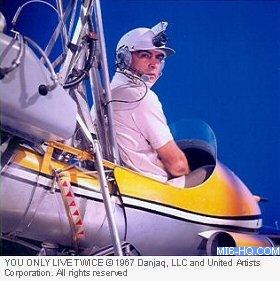
Above: Sean Connery films close-ups
in Little Nellie at Pinewood, UK. |
When the movie did open, it would play in a handful
of selected theaters in New York City before going into wide release.
My dad and I went to the old Astor Theater in Times Square to
see it and I was in Double-0 Heaven. At age 10, I was oblivious
to the plot inconsistencies and was caught up in the eye-popping
visual effects, John Barry’s magnificent score and Ken Adam’s
superlative volcano set. Is there really anything today’s
CGI-obsessed film industry can provide that can equal what these
great artists and technicians contributed to the films of this
era? When the film came to neighborhood theaters, another ritual
took place: all of the boys would pool their meager allowances
and go to the film day after day until the funds ran out. At 50
cents a ticket (25 pence by today’s standards for you Brits),
you could go to about five shows before the money train slid to
a full stop.
How does Twice hold up today? Very well
indeed, in my humble opinion. It’s merits are such
that you don’t have to call the film a guilty pleasure
a la Moonraker or A
View to a Kill.
| 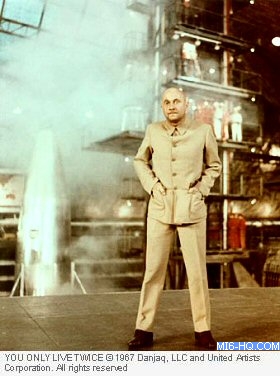 Above:
Donald Pleasence as Blofeld Above:
Donald Pleasence as Blofeld
|
|
I’ve never been able to assemble
a reasonable argument to counter all those who point out
the film’s shortcomings, except to say that –
given the fact it’s one big mess – it’s
a magnificent mess, at that. It was a logistically difficult
film to make and not a happy one for those involved. The
rift between Connery and the producers over financial
and
creative issues had widened to a full chasm following the
actor’s recent insults about them in his famous
Playboy interview. Connery was already counting the days
until his
retirement from “Bondage” when he arrived on
location in Japan – only to find the usually respectful
and demure Japanese press as obnoxious as their western
counterparts.
Simultaneous to this, producers Broccoli
and Saltzman were feuding about issues in their partnership
and Connery’s marriage to actress Diane Cilento was
showing signs of breaking down. Shortly after production
began, actor Jan
Werich who was to play the screen’s first Blofeld,
was taken ill and had to be replaced by Donald
Pleasence. It’s a testament to the professionalism
of all involved that the film turned out as well as it
did. |
Writing about You Only Live Twice for this MI6
tribute, I confess to having the urge to see the film again.
It’s
been a few years and the old appetites from childhood are re-emerging.
I hate to be a sucker for a marketing campaign but in this case,
I’ll willingly go along with the tag line from the film
poster: “…Twice is the only way to live!”
- Lee Pfeiffer, 2007
Lee Pfeiffer is the co-author (with Dave Worrall) of the
best-selling book, The Essential James Bond (Boxtree,
U.K; Harper
Collins, USA). He is also the Editor-in-Chief of Cinema
Retro magazine, dedicated to films of the 1960s and 1970s.
Thrice as good...
Dave Worrall -- Although I
had been fortunate enough to have seen the Aston
Martin DB5 on display at Rackhams Store in Birmingham, and
saw Thunderball
on its initial release on the big screen, it was You
Only Live Twice that was my Bond ‘coming of age’
moment.
I was fourteen years of age when Twice was released
in the summer of 1967, and what a summer to remember! In those
days major films were launched to tie-in with the holiday season
and shown at seaside resorts for a minimum of three months. In
most cases a ‘children’s’ film would be shown
in the afternoon and an ‘adult’ one in the evening
– thus ensuring maximum ‘bums-on-seats’ revenue
for both the cinema and distributor. I saw the fifth James Bond
extravaganza in Newquay, Cornwall, and remember stopping at the
cinema to view the quad posters – all three of them, on
the way to the beach every day. Although the Bond films were by
now a phenomenon in their own right, for some reason this was
even more special, as summed by in the dialogue of the immortal
Bernard Lee; “This is the big one double-O-seven”.
And it certainly was.
Back then, to gain maximum exposure,
every store in town was given a hanging card advertising
the film, similar in the way circus acts are still advertised
today. This was my first ‘mission’ of the holiday
– to acquire one. However, with the film still having
five more weeks to run store owners were reluctant to let
one go, much to my disappointment.
Still, all was not lost – Somportex, who produced the James Bond bubblegum
cards, had a new set out, and this time, rather than a card,
a plastic strip replicating scenes from the film was issued
as though 35mm slides. Each packet contained a strip, a
card mount to hold one of the slides, and, oh yes, some
bubblegum! I spent nearly my entire pocket money buying
packet after packet, and even managed to persuade the store
manager to let me have the counter display box – well,
after all, I had bought them all! |
|
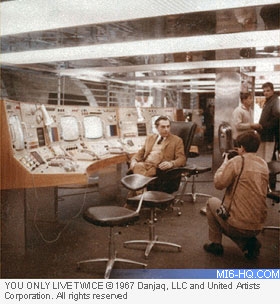
Above: Very rare photo of Ken Adam posing
for a journalist in the control room, which was part of the
vast volcano set. Photo courtesy of Lee Pfeiffer. |
Eventually, one night my mother and father took
me to see the film. There were queues around the cinema when we
arrived. My heart beat like crazy: would we get in? Of course,
we did, and I sat in awe as the film unfolded in spectacular fashion
on the widescreen. John Barry’s score, still to this day
one of his finest, set the mood and tempo for this rollercoaster
of a movie – Bond had never been better or bigger. Little
Nellie, the Toyota
car chase, the kidnapping of space rockets; simply too much to
take in for a fourteen year-old Bond fan. So was this what heaven
was like?
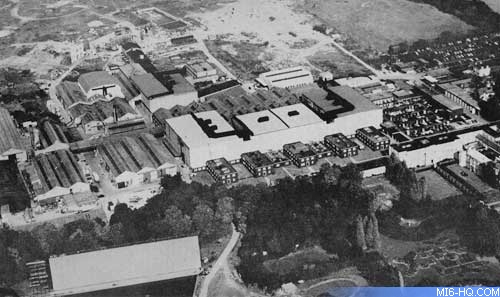
Above: Pinewood Studios circa 1968/9. The large area at the top (centre) is where the Volcano set was built. Today, where you can see the water tank to the left of this area, is where the OO7 Stage now stands. Notice where the Fort Knox set was built (top left).
Photo courtesy of Dave Worrall.
|
Of course, the major ‘star’ of the
film was Blofeld’s secret HQ hidden in the depths of an
extinct volcano. No CGI here – this was the real thing,
and even though statistics have been banded around since, I guarantee
this is still the largest set built for a James Bond film. I know
– because I saw it! Back in 1966 I spent several weeks staying
with an aunt and uncle in London as part of my summer break, a
time I still remember with fondness. Here I was, a young lad from
Birmingham going away from home without my parents and staying
in the capital city. Back then this was a big deal. Today, I drive
the same distance to London just to see a movie and come back
again!
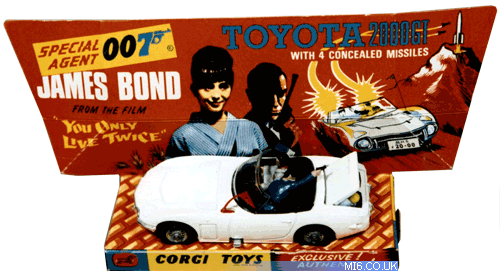
Above: Toyota Car and original box
art.
Both original collectables from the collection of Dave
Worrall.
|
My uncle Steve was a rep for Gillette, and they
supplied all the major studios in and around the London area with
razor blades, make-up and the like. One day he asked if I would
like to go out with him for the day. Not wishing to be rude, I
reluctantly agreed, thinking what a boring day this would be visiting
offices. It was the best ‘worst’ decision of my life,
as one of those ‘boring offices’ happened to be Pinewood
Studios, twenty miles on the outskirts of the city. As we drove
in, there was this huge, and I mean huge, construction site to
the right of us on what I later came to learn was the backlot.
After visiting the make-up department my uncle took me over to
the site, or as close as we were allowed, where one of the builders
told us what it was – the set for the new James Bond film.
Can you believe it? A Bond fan since the age of nine, and here
I was looking at a set for one of the films – instant erection
time!
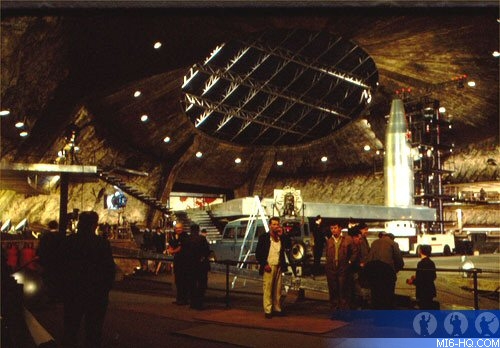
Above: Rare, never-before-published
photograph taken on the Volcano set during the filming
of You Only Live Twice. © 1967 John Beaumont. Courtesy
of Cinema Retro magazine.
|
The ‘building’ was huge, about the
height of a six-storey building, and was a mass of scaffolding
and canvas. There was a roadway each side for carrying equipment
to the (as I was told later) the ‘floor’ of the set,
which was the inside of a volcano and housed a rocket base, the
height dictated by the size of a rocket that would rise from within.
This was all amazing stuff, and I went home that night knowing
I had seen something really special – and I had.
And now, some forty years later, I would never have believed
back then that I would end up being involved in the Bond business
professionally, and visiting Pinewood Studios on a regular basis.
However, I still get just as much of a thrill driving through
the entrance and seeing the OO7 Stage on the backlot as I did
when I first saw the Volcano set all those years ago as a youngster
– and I still have the gum cards, paperback book and Corgi
toy car from the film. Will I ever grow up? Never – ‘grown
ups’ are boring people.
- Dave Worrall, 2007
Dave Worrall is the author of The Most Famous Car in the
World, the history of 007’s Aston Martin DB5. He is also
the co-founder and publisher of Cinema
Retro magazine, dedicated to films of the 1960s and 1970s.
The
views of this columnist and those expressed in this article are
not necessarily those of mi6-hq.com or its owners.